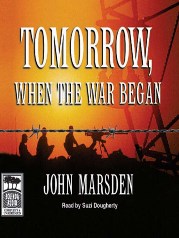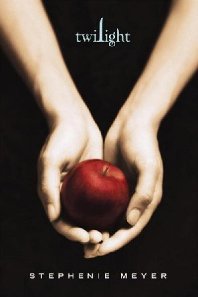 I have recently just finished reading the ‘Tomorrow When the War Began’ series, over the holidays. It was about eight teenagers who took a trip to a bushland area, up in the mountains, above their town called Wirrawee.
I have recently just finished reading the ‘Tomorrow When the War Began’ series, over the holidays. It was about eight teenagers who took a trip to a bushland area, up in the mountains, above their town called Wirrawee.
While they were on their trip, the annual show, at the Wirrawee Showground, took place. When the eight teenagers – whose names were Fi, Homer, Lee, Kevin, Corrie, Robyn, Chris and Ellie – came home they found that the town had been deserted, with all the animals left to die. They searched the house trying to find some kind of note or something else from one of their parents that told them where they were, but they couldn’t find them. So they thought back to a previous discussion that they had when they were on their trip and thought that maybe it was the start of World War III.
So they evacuated to the place that they had camped at before, and taking with them more supplies – just in case they had to stay for longer than they had been hoping.
I found that the start of the nook was mysterious, as it didn’t really introduce the characters to a full extent which would give us – the readers – a better understanding of the personalities and relationships of the group of teenagers. But when I got into the book more, I could understand more of what and why the people said the things that had been written down in the book.
Reading on, it introduced the fact that the main character, Ellie, was appointed to write a kind of diary about what happened to these teenagers in the war, and that became what the books were based upon – the thoughts, feelings and all of the groups actions. And I thought that by finding this out it helped me to get know Ellie and her relationships with her friends that were stranded in a place that they called Hell.
Reading these books, as a teenager myself, I could relate to most of the problems and feelings that Ellie and her friends faced, such as the feelings of insecurity – because you missed someone or something that in a way kept you afloat and secure; anger – because someone or something did something to you that you couldn’t forgive; and most of all the feeling of being scared, which I can relate to well.
I thought that in these books, author John Marsden, depicted the thoughts and actions that would occur in a situation like they experienced in the books, very well. It was as if John Marsden himself, was a teenager and was actually in the war.
The series, had a very intense amount of violence. However, I liked it in a way that over all that was happening, Ellie could write exactly what happened and what she felt when they began to fight back to the enemy soldiers for their country. For one, if I did at least one of the things they did in the book, even thinking about it would make me hysterical and I couldn’t live with myself for killing somebody and also, for a second, I found it weird that in between the action that Ellie could have enough time to write anything.
I was also surprised that in their state of mind, they could put together and nearly always pull off the things that they did, such as, blowing up mowers to kill the soldiers that were chasing them and firing shots at them, rescuing a member of their group from a very inhabited place for the enemy, who was shot in a bulldozer, by placing him in the shovel and then driving like mad to get away.
The list continued with major targets like blowing up large numbers of enemy patrols, the destruction of the main source of enemy activity and the strongest place in all of Wirrawee, that carried nearly all of the enemy’s ammunition – which was Cobblers Bay, a very powerful harbour, they also blew up the senior officer’s headquarters and also the fact that they dealt with the deaths of people from the group, parents, siblings, other friends and animals, and still being able to live through to the end of the war.
In the books, it highlighted the fact that when a country is in need of help, surrounding countries will sometimes come to the aid of the country. In these books, New Zealand’s soldiers accommodated the teenagers, when they contacted New Zealand with the information of the blowing of Cobblers Bay. And I think that because of that, it kind of brings the book to life and makes it feel real, because if something bad happened to a country in reality, the other countries will come to their aid.
Another thing that was very obvious in all of the books was the friendship of the group. It was as if the bond between them was stronger than a sibling, and close to the bond of a parent and a child.
The love between them was a love that was set in concrete ,and it showed in the friendship that even went through their minds and hearts when someone or some people killed several people. (Which was nearly all the time to protect one another but other times to keep the secret of where, who and what these people were).
Overall, I loved the whole series, and every night, I couldn’t wait to read the books. This series is perfect for teenagers in particular and most adults, because I think there is something in there for everyone.
Note: ‘Tomorrow When the War Began’ is being made into a movie, due for releas in 2010. The screenplay is being written by Stuart Beattie who was involved in the ‘Pirates of the Carribean’ trilogy.
See the movie trailer below, one of many from YouTube:
 Over the holidays, I read ‘Twilight’ for the second time; the last time I read ‘Twilight’ was last year. Now that I have read it for the second time, I see a completely different side of it.
Over the holidays, I read ‘Twilight’ for the second time; the last time I read ‘Twilight’ was last year. Now that I have read it for the second time, I see a completely different side of it. Lina finds a beautiful box in her house and discovers a message from the builders. She talks to her friend Doon about it, to see if he knows anything on what it means. In times of trouble the city is going in to hibernation with people running round stealing food and doing all kinds of crazy things. Will this get in the way of lina and Doon finding the way out of ember?
Lina finds a beautiful box in her house and discovers a message from the builders. She talks to her friend Doon about it, to see if he knows anything on what it means. In times of trouble the city is going in to hibernation with people running round stealing food and doing all kinds of crazy things. Will this get in the way of lina and Doon finding the way out of ember? ‘A Rose for the Anzac Boys’ is an extraordinarily well researched book by Jackie French about the experience of World War I from the viewpoint of three young teenage girls. Midge Macpherson is a 16 year old New Zealander studying at an exclusive private school in England, when she becomes friends with two English girls, Ethel and Anne. They are mildly engaged in the war effort at the school, rolling bandages, but things become more urgent when Midge’s twin, Tim, is listed as “missing” from the Gallipoli campaign.
‘A Rose for the Anzac Boys’ is an extraordinarily well researched book by Jackie French about the experience of World War I from the viewpoint of three young teenage girls. Midge Macpherson is a 16 year old New Zealander studying at an exclusive private school in England, when she becomes friends with two English girls, Ethel and Anne. They are mildly engaged in the war effort at the school, rolling bandages, but things become more urgent when Midge’s twin, Tim, is listed as “missing” from the Gallipoli campaign. The City of Ember is a mysterious place, where all the lights go out at 9 each night, everyone rises early for breakfast. Lately, the lights have been flickering. Supplies are shorter each year, and many supplies and foods are no longer available in Ember.
The City of Ember is a mysterious place, where all the lights go out at 9 each night, everyone rises early for breakfast. Lately, the lights have been flickering. Supplies are shorter each year, and many supplies and foods are no longer available in Ember. ‘Dragon Rider’ is a story where a group of dragons’ home is in danger. They do not have the power to stop such a disaster, so a young dragon called Firedrake and his brownie friend, Sorrel, set out on a journey to look for the one place them and the other dragons will be safe, the Rim of Heaven. On their travels, they make friends with a boy called Ben and the three of them search for this lost land. They have help from many friends along the way, but a fiend watches in the darkness. One who wants Firedrake to find the Rim of Heaven; but not so the dragons are safe – so he can destroy the last dragons on Earth.
‘Dragon Rider’ is a story where a group of dragons’ home is in danger. They do not have the power to stop such a disaster, so a young dragon called Firedrake and his brownie friend, Sorrel, set out on a journey to look for the one place them and the other dragons will be safe, the Rim of Heaven. On their travels, they make friends with a boy called Ben and the three of them search for this lost land. They have help from many friends along the way, but a fiend watches in the darkness. One who wants Firedrake to find the Rim of Heaven; but not so the dragons are safe – so he can destroy the last dragons on Earth.

